| Listing 1 - 10 of 61 | << page >> |
Sort by
|
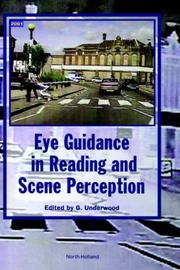
ISBN: 9780080433615 0080433618 0585473986 9780585473987 0080506232 9780080506234 1280927267 9781280927263 9786610927265 Year: 1998 Publisher: Amsterdam Elsevier
Abstract | Keywords | Export | Availability | Bookmark
 Loading...
Loading...Choose an application
- Reference Manager
- EndNote
- RefWorks (Direct export to RefWorks)
The distinguished contributors to this volume have been set the problem of describing how we know where to move our eyes. There is a great deal of current interest in the use of eye movement recordings to investigate various mental processes. The common theme is that variations in eye movements indicate variations in the processing of what is being perceived, whether in reading, driving or scene perception. However, a number of problems of interpretation are now emerging, and this edited volume sets out to address these problems. The book investigates controversies concerning the variations in
Eye --- Visual perception --- Movements --- Visual perception. --- Movements.
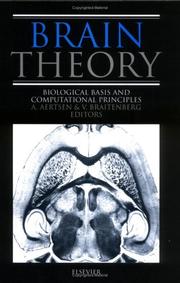
ISBN: 9780080528298 0080528295 9780444820464 0444820469 1283246376 9781283246378 9786613246370 Year: 1996 Publisher: New York Elsevier
Abstract | Keywords | Export | Availability | Bookmark
 Loading...
Loading...Choose an application
- Reference Manager
- EndNote
- RefWorks (Direct export to RefWorks)
The present collection of papers focuses on the subject of vision. The papers bring together new insights and facts from various branches of experimental and theoretical neuroscience. The experimental facts presented in the volume stem from disparate fields, such as neuroanatomy, electrophysiology, optical imaging and psychophysics. The theoretical models in part are unsophisticated, yet still inspiring, while others skilfully apply advanced mathematical reasoning to results of experimental measurements. The book is the fifth in a series of volumes intending to define a theory of the brain by
Periodical
Abstract | Keywords | Export | Availability | Bookmark
 Loading...
Loading...Choose an application
- Reference Manager
- EndNote
- RefWorks (Direct export to RefWorks)
Vision, Ocular. --- Visual Perception. --- Vision
Book
ISBN: 9814366439 Year: 1991 Publisher: Singapore ; Teaneck, NJ : World Scientific,
Abstract | Keywords | Export | Availability | Bookmark
 Loading...
Loading...Choose an application
- Reference Manager
- EndNote
- RefWorks (Direct export to RefWorks)
This book considers computer vision to be an integral part of the artificial intelligence system. The core of the book is an analysis of possible approaches to the creation of artificial vision systems, which simulate human visual perception. Much attention is paid to the latest achievements in visual psychology and physiology, the description of the functional and structural organization of the human perception mechanism, the peculiarities of artistic perception and the expression of reality. Computer vision models based on these data are investigated. They include the processes of external d
Artificial intelligence. --- Cognition. --- Visual perception. --- Computer vision.
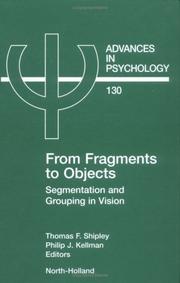
ISBN: 0444505067 9786610927388 1280927380 008050695X 9780444505064 0585473994 9780585473994 9780080506951 Year: 2001 Publisher: Amsterdam ; New York : Elsevier,
Abstract | Keywords | Export | Availability | Bookmark
 Loading...
Loading...Choose an application
- Reference Manager
- EndNote
- RefWorks (Direct export to RefWorks)
From Fragments to Objects
Visual perception --- #PBIB:2002.1 --- Optics, Psychological --- Vision --- Perception --- Visual discrimination --- Psychological aspects --- Visual perception.
Multi
ISBN: 9780857099242 0857099248 0857092294 9780857092298 Year: 2014 Publisher: Cambridge, [England] ; Waltham, [Massachusetts] : Woodhead Publishing : The Textile Institute,
Abstract | Keywords | Export | Availability | Bookmark
 Loading...
Loading...Choose an application
- Reference Manager
- EndNote
- RefWorks (Direct export to RefWorks)
Colour and appearance perceptions are very complex psychological phenomena. Written by one of the foremost authorities in the field, Principles of Colour and Appearance Measurement is a major two-volume work addressing the key topics required to understand the issues and manage colour effectively. The book addresses how objects appear to viewers, how viewers perceive colour, and the major types of instrumentation used to measure colour. Chapters detail the characteristics of light sources and object colour and appearance attributes. They encompass the complexities of human visual perception, including the various causes and types of colour blindness, and other unusual visual phenomena. The book also covers colour measurement instruments and methods, as well as fluorescence and whiteness. Principles of Colour Appearance and Measurement is a comprehensive resource for designers, colour technologists, colour quality inspectors, product developers, and anyone who uses colour in their work.
Analytical chemistry. --- Colorimetry. --- Spectrum analysis. --- Color. --- Color Perception. --- Visual Perception.
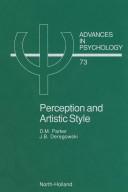
ISBN: 0444887024 9786611789305 1281789305 0080867278 9780080867274 9781281789303 9780444887023 Year: 1990 Publisher: Amsterdam ; New York : New York, N.Y., U.S.A. : North-Holland ; Distributors for the U.S. and Canada, Elsevier Science Pub. Co.,
Abstract | Keywords | Export | Availability | Bookmark
 Loading...
Loading...Choose an application
- Reference Manager
- EndNote
- RefWorks (Direct export to RefWorks)
Perception and Artistic Style explores the role of visual processes in the creation and perception of painting and drawing. By looking at the relationship between perception and representation evidence is provided that purely visual processes are a richer source of artistic inspiration than is commonly realised. Many of the obvious variations in artistic style are firmly rooted in visual perception and visual cognition. This book looks at a range of fundamental visual processes and investigates their contribution to major stylistic features of works of art. A wide selection of pictures is cons
Art --- Psychology --- Visual perception --- Art - Psychology. --- Visual perception. --- Optics, Psychological --- Vision --- Perception --- Visual discrimination --- Psychology. --- Psychological aspects
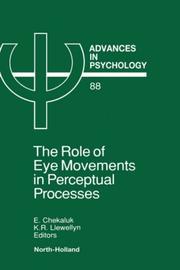
ISBN: 044489005X 9786611789589 1281789585 0080867421 9780080867427 9781281789587 9780444890054 Year: 1992 Publisher: Amsterdam North Holland
Abstract | Keywords | Export | Availability | Bookmark
 Loading...
Loading...Choose an application
- Reference Manager
- EndNote
- RefWorks (Direct export to RefWorks)
It has become a truism that the frozen optical diagram representation of vision is the worst possible picture of the way in which we visually interact with the environment. Even apart from our reaction to moving targets by pursuit movements, our visual behaviour can be said to be characterised by eye movements. We sample from our environment in a series of relatively brief fixations which move from one point to another in a series of extremely rapid jerks known as saccades. Many questions arising from this characteristic of vision are explored within this volume, including the question of how
Visual Perception. --- Eye --- -Visual perception --- Optics, Psychological --- Vision --- Perception --- Visual discrimination --- Eyeball --- Eyes --- Visual system --- Face --- Photoreceptors --- Perception, Visual --- Perceptions, Visual --- Visual Perceptions --- Vision, Ocular --- Movements --- Psychological aspects --- EYE MOVEMENTS, physiology --- Visual perception. --- Eye Movements --- Movements. --- physiology. --- Visual perception --- Visual Perception --- Eye movements --- Ocular motility --- Oculomotor system --- Biomechanics --- Rapid eye movement sleep --- Visual Processing --- Processing, Visual
Book
ISBN: 0128235675 0128235683 9780128235683 9780128235676 Year: 2021 Publisher: Morgan Kaufmann,
Abstract | Keywords | Export | Availability | Bookmark
 Loading...
Loading...Choose an application
- Reference Manager
- EndNote
- RefWorks (Direct export to RefWorks)
Visual Thinking for Information Design, Second Edition brings the science of perception to the art of design. The book takes what we now know about perception, cognition and attention and transforms it into concrete advice that students and designers can directly apply. It demonstrates how designs can be considered as tools for cognition and extensions of the viewer's brain in much the same way that a hammer is an extension of the user's hand. The book includes hundreds of examples, many in the form of integrated text and full-color diagrams. Renamed from the first edition, Visual Thinking for Design, to more accurately reflect its focus on infographics, this timely revision has been updated throughout and includes more content on pattern perception, the addition of new material illustrating color assimilation, and a new chapter devoted to communicating ideas through images.
Informationsgrafik --- Visuelle Kommunikation --- Visual perception. --- Optics, Psychological --- Vision --- Perception --- Visual discrimination --- Nichtverbale Kommunikation --- Infografik --- Informationsgraphik --- Infographic --- Gebrauchsgrafik --- Psychological aspects --- Design --- Information visualization --- Visual perception
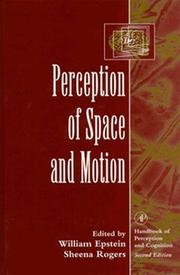
ISBN: 0122405307 9780080538617 0080538614 1281032840 9781281032843 9780122405303 9786611032845 Year: 1995 Publisher: San Diego (Calif.): Academic press
Abstract | Keywords | Export | Availability | Bookmark
 Loading...
Loading...Choose an application
- Reference Manager
- EndNote
- RefWorks (Direct export to RefWorks)
During the past 25 years, the field of space and motion perception has rapidly advanced. Once thought to be distinct perceptual modes, space and motion are now thought to be closely linked. Perception of Space andMotion provides a comprehensive review of perception and vision research literature, including new developments in the use of sound and touch in perceiving space and motion. Other topics include the perception of structure from motion, spatial layout,and information obtained in static and dynamic stimulation.Spatial layoutStructure from motionInformation on stat
Affective and dynamic functions --- Picture perception --- Space perception --- Visual perception --- Perception des images --- Perception spatiale --- Perception visuelle --- Motion perception (Vision) --- Space perception. --- Picture perception. --- Visual perception.
| Listing 1 - 10 of 61 | << page >> |
Sort by
|

 Search
Search Feedback
Feedback About UniCat
About UniCat  Help
Help News
News